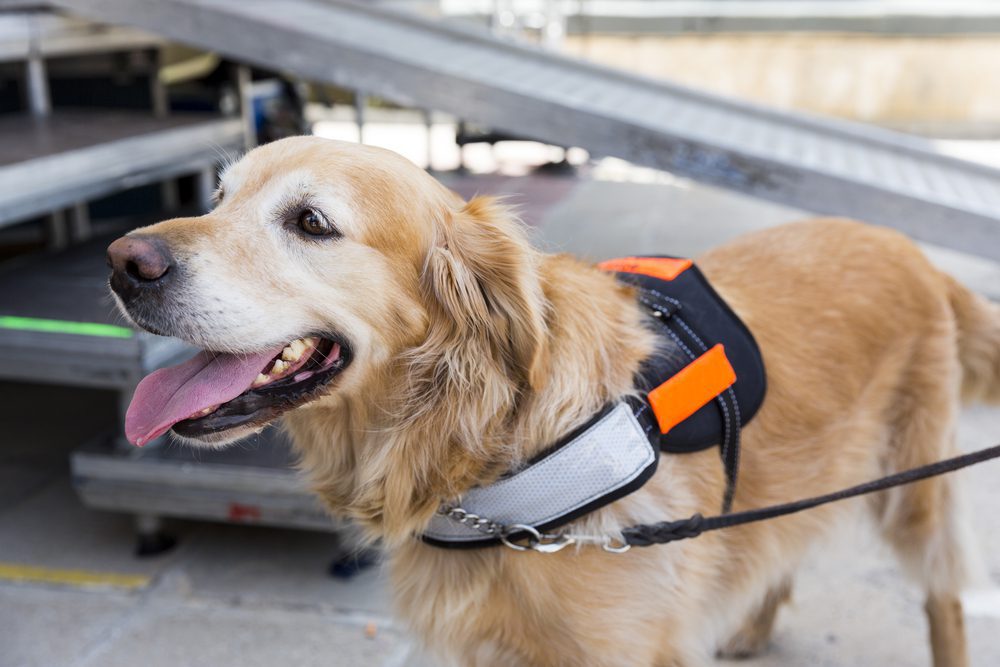Share This Article
If you’re wondering whether you can bring a Psychiatric Support Dog (PSD) with you on a plane, the short answer is “yes.”
The Americans with Disabilities Act provides a wide range of protections to service animals that assist their handler with a physical or psychiatric disability. The Act prohibits public accommodations—such as venues and transportation services, including airports—from discriminating against trained service animals accompanying a person with a disability.
Furthermore, the Air Carrier Access Act also states that airlines must not discriminate against service animals and their handlers. Therefore, federal law gives you the right to bring a trained PSD into the airport and onto the cabin of an aircraft at no extra charge.
However, you’ll need to abide by certain conditions and fill out some paperwork before your flight. To help you prepare for the process, we’ve put together this comprehensive PSD air travel guide.
What Is a Psychiatric Service Dog?
A PSD must be individually trained to assist its handler with an American Psychiatric Association-recognized disability. Eligible disabilities include but are not limited to: anxiety disorder, Post Traumatic Stress Disorder (PTSD), bipolar disorder, and Attention Deficit Hyperactivity Disorder (ADHD).
The ADA doesn’t require any formal certification to verify a PSD. However, the animal must be well-behaved and individually trained to assist with essential tasks relating to the handler’s disability.
Common psychiatric service dog tasks may include but are not limited to: fetching medication, grounding the handler during a PTSD flashback, initiating tactile intervention, and guiding the handler in the event of a dissociative episode.
Can an Emotional Support Animal Travel on a Plane?

An Emotional Support Animal (ESA) provides emotional comfort to its handler. These differ from psychiatric service animals, both in their role and the protections they receive under federal law.
- An ESA provides comfort and emotional support to its handler by simply being present.
- A PSD is individually trained to perform specific tasks to assist its handler with an APA-recognized disability.
While ESAs were previously permitted to accompany their handlers in the airline cabin at no extra cost, legislation has recently changed. As of December 2020, the US Department of Transport (DOT) no longer considers an ESA to be a service animal. Therefore, ESAs don’t receive special legal protections and must fly in the cargo hold, just like any other pet.
If you would like your ESA to accompany you on a flight, you have two options:
- Pay the relevant fee to have the animal transported in the cargo hold.
- Train your dog to become a PSD by performing specific tasks that assist you with an eligible disability.
Documentation: What You Need to Do to Bring a Psychiatric Service Dog on a Plane
While a person with a disability has the legal right to bring a PSD onto an aircraft, there is some paperwork required.
When booking travel more than 48 hours before departure, you will need to download and complete the US Department of Transportation Service Animal Air Transportation Form, then submit it to the relevant airline.
The form asks a series of questions to verify the handler’s identity as well as the health, training, and behavior of the animal. One question asks for details on the “Animal Trainer or Training Organization.” If you have self-trained your service dog, which is permitted under the ADA, you can put your own name into this field.
You can fill out the form on a computer then save it as a PDF document for submission, although you’ll need to insert an e-signature into the relevant field. Another option is to print it off, fill it out in pen, then scan it before submitting the file to the airline.
Where to submit the form depends on the airline in question. Most have an online portal or an email address for a Special Assistance Desk. If you can’t find where to submit it or haven’t received a prompt comfirmation, you should call the airline.
Booking 48 hours or more in advance means there’s no obligation to check in at the service desk—online check-in is allowed.
When booking travel less than 48 hours in advance, travelers must fill the form out in person at the airport check-in desk. Ensure you arrive at the airport early to allow sufficient time.
In either case, print out a copy of the form and carry it with you.
Also, take great care to fill out the form accurately. As it serves as a Statutory Declaration, any untrue or incorrect information could result in heavy penalties.
Documentation for Flights Over Eight Hours
If your total flight time exceeds eight hours, you’ll need to complete and submit the DOT Service Animal Relief Attestation Form as well.
This form certifies that your service animal will either refrain from relieving itself during the flight or do so in a way that doesn’t damage airline property or pose a hygiene risk for other passengers.
You will be liable to pay for any damages your pet may cause through urination or defecation.
Airline Service Animal Identification Number
Upon approval, most airlines will send an ID number for verification.
This number is unique to every airline (AA calls it an SVAN ID, for example) and may allow you to travel again with that particular airline without re-doing the paperwork. However, if the airline permits auto-approval, it will likely only be for a set timeframe, typically one year.
Regardless of who you fly with, it’s wise to keep this number at hand during each trip.
Taking a Psychiatric Service Dog Through an Airport

The ADA mandates that staff at public accommodations, including airports, may only ask the following two questions:
- Is the dog a trained service animal that assists with a disability?
- What tasks has the animal been trained to do?
A staff member may not ask you questions about your disability or the training your service dog has undertaken. Furthermore, no one may force you to demonstrate your service dog’s ability to perform its tasks.
Although there’s no legal requirement to use a vest or ID card, service dog apparel can make identification easier. A vest and ID card instantly communicate to staff and the public that you’re accompanied by a trained service animal rather than an ordinary pet. That way, you may experience less hassle and questions, both at the airport and in other public accommodations.
A PSD may accompany you to any area of the airport, including restaurants and bathrooms. However, it must be well-behaved, non-aggressive, and housebroken at all times. If a service animal creates a nuisance, mess, or safety issue, a public accommodation has the legal right to force the animal to leave.
All airports in America are legally required to have an animal relief area. As you could be liable for any damage to an aircraft caused by defecation or urination, it’s worth taking your PSD here to give it one last chance to go to the toilet before boarding. To locate the animal relief area, check the airport map or ask ground staff for directions.
Taking a Service Animal Onboard
Once onboard the aircraft, your service animal will need to remain calm, quiet, and abstain from acting aggressively against passengers and crew. Service animals lose their legal protections if they exhibit disruptive behavior.
Disruptive behavior may be defined as:
- Barking
- Biting or attempting to bite
- Lunging
- Intruding on another passenger’s space
If your PSD starts misbehaving, you may have the opportunity to correct the bad behavior. Failure to do so promptly will revoke your legal protections. In this situation, the animal will be treated like any other pet and must travel in the cargo hull for a fee. Due to the time required to organize these arrangements, you’ll likely miss your flight and have to book an alternative service.
You and your service dog must also comply with numerous other DOT conditions:
- The dog must be harnessed or leashed at all times
- The dog must fit under your seat, by your feet, or on your lap, without intruding on another passenger’s space
- The dog must be four months old or older at the time of the flight
- The dog must be no larger than a two-year-old child if traveling on your lap
- A passenger may not bring more than two service animals onboard
Note that the DOT only provides protections for service dogs. Other animals are no longer allowed in the cabin.
During the flight, a service dog must not:
- Exhibit disruptive behavior
- Sit in an exit row
- Block the aisle
- Eat off the tray table
With the Right Training, Service Dogs Can Take Off
Although airlines are legally obliged to permit service dogs in an aircraft cabin, the animal must behave appropriately throughout the flight and comply with all DOC conditions.
Therefore, it’s essential you properly train your service animal beforehand, preferably with an in-depth focus on public access training. Dog Academy has a comprehensive selection of scientifically proven training programs, all using reward-based training methods rather than negative reinforcement.
